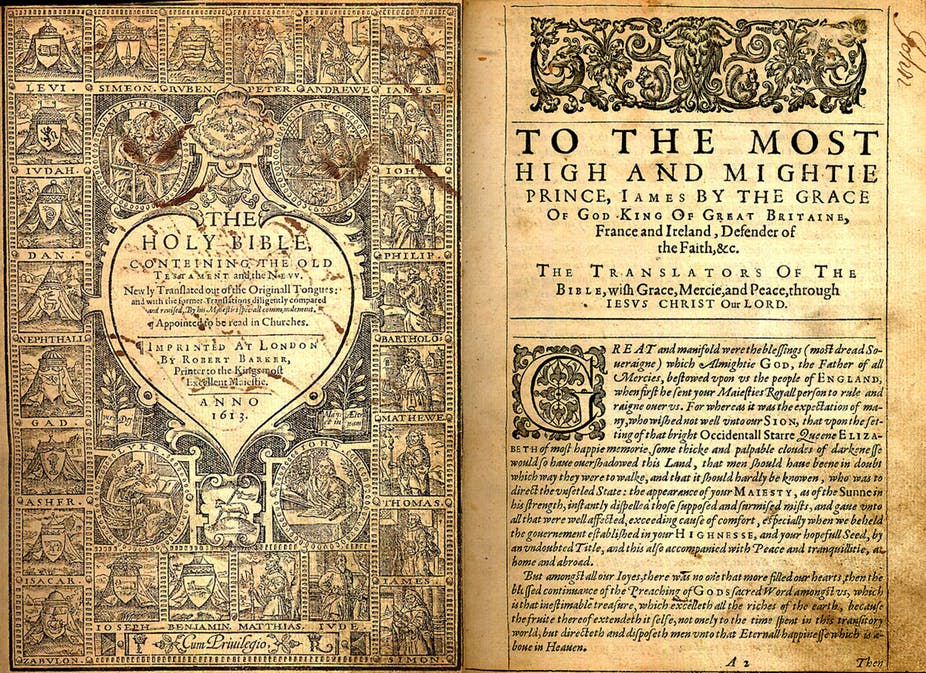
Many have shaken off King James as being antiquated or too hard but with this blog post I want to show why that it is still culturally relevant as well as simpler than Shakespeare. The King James Version of the Bible is certainly still an excellent version of the Bible–and dare I say–perhaps even the best? Here are four Reasons why:
- It is the most accurate- from a translators point of view. I majored in Biblical Studies with an emphasis on the languages and thus took 4 years of Greek and a year of Hebrew. Looking at the translations on the market good ‘ol KJV still wins out in my book. Most modern translations are so hyper focused on making the words sound relevant that they at best have dumbed down scripture and at worst have super imposed their worldview into their attempts to make scripture culturally relevant. I want none of that. Give me the best translation you can come up with and keep it literal to the Bible. Let the Holy Spirit guide me (and others who read) and show each of us what it means. I want the actual Words of the Lord! Keep it as close to that as possible. (For which reason we also learn Greek and Hebrew!)
- Newer translations cut out parts of the Bible. This is a shocking controversy that needs to be well known. You cannot say you have a copy of the Bible when verses are missing from it. Many modern translations use the Wescott and Hort translation and these men actually hated God and cut out many of the most important parts of Scripture. Try googling “verses missing from NIV” or your particular translation and you will find some very important Bible verses have been omitted. There will literally be a verse number in your Bible but no words written. People like to say that it is because they are relying on “older texts” but just because a text is older does not necessitate authenticity. It could be a gospel that had been messed with by the Alexandrian gnostics and sat on a shelf and was preserved due to its disuse. Age is not the only factor to be considered.
- It will broaden your vocabulary. Even for children! My children listen exclusively to the King James Version Bible when my husband reads to the and they memorize all their verses in KJV. It really isn’t that hard. It’s kind of like learning another language but not even nearly that difficult. The children love listening to my husband read the Bible at night and they are really listening and learning! They ask the most astute questions. Learning KJV makes all other reading simpler. Shakespeare is a great example. They don’t need everything dumbed down.
- It captures the true poetic essence of the Bible. Take for example 1 Peter 1:13, here’s how the KJV accurately translates the Greek of the passage:
“Wherefore gird up the loins of your mind …”
I Peter 1:13
Peter is talking in this chapter of the “trial” of faith that every Christian must endure in the “heaviness of manifold temptations” that the Christian experiences during his “time of … sojourning” on this earth. In other words, at least “for a season,” we are to see ourselves in a personal battle against the evil influences of this world. And to express this, Peter uses a word picture of the soldier preparing for war.
Here’s the text with which a particular modern translation replaces (not translates) the Greek:
“Therefore, with minds that are alert and fully sober …”
I Peter 1:13
This is a terrible way of rendering this passage! It simply does not pick up all of the meaning of the original metaphor. It can’t.
The problem seems to be that modern translators simply do not understand poetic expression, and since much of the Bible—even in what is otherwise prose—is given in poetic expression, they are not suited to translate it! If they did understand poetic expression, they would not assume that non-metaphorical language is somehow more “accurate” or even “understandable” than metaphorical expression.
Removing the poetry of the Bible, far from making it more understandable, does the exact opposite. This is why good writers like C. S. Lewis use frequent metaphors. People who write with clarity use more, not fewer, metaphors.
Many modern translations are works of linguistic taxidermy. They claim they can deliver to readers a Bible they can understand but they’ve taken something that is living and made it dead. I rather think they are more like paraphrases. But if one could argue they are real translations, then they’re real dead ones—stuffed and mounted for our hermeneutical convenience by scholars who don’t know the difference between a living and a dead language.
The translator of 1611 wrote with a pen of iron, and with the point of a diamond. The modern translator writes with Word, published by Microsoft. And it shows.
Martin Cothran
Christian Studies Curriculum that Uses KJV or NKJV
Memoria Press has an amazing Christian Studies Curriculum for all ages based on age appropriate content taken directly from the NKJV. As the children progress and get older they memorize scripture, study pertinent maps from the Bible story, look at difficult vocabulary, etc. It is really an incredible study. One of my favorites.
Here is a Youtube review I did on the Golden Children’s Bible which is used in the 3rd-8th grade MP Christian Studies Curriculum: https://youtu.be/6yAosirx9tc
A Beka also has a wonderful King James Version Christian Studies Curriculum. They use what they call “Flash-a-cards” and each very well done picture goes with the teachers scripted narraration. That’s the part I didn’t love. If you don’t know the Bible well you’ll end up just reading every word. Some things I didn’t completely agree with theologically so I just skipped over that bit. But the pictures, the KJV memory verses, the hymns are all coordinated to the curriculum. You could just opt to read the Bible verse passages, they are listed on the flash-a-cards but the narrarations are a nice retelling.
